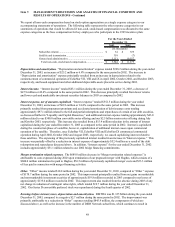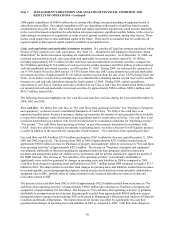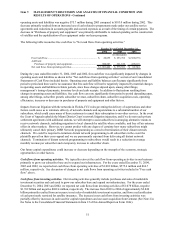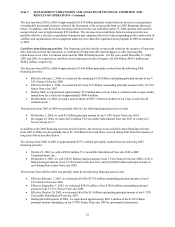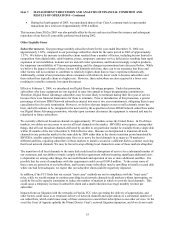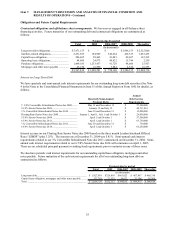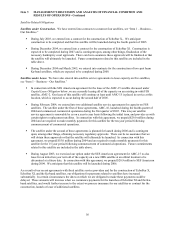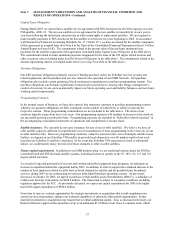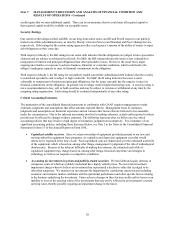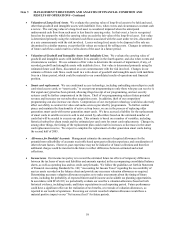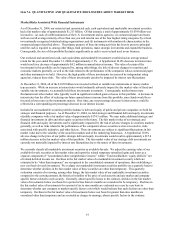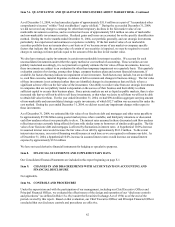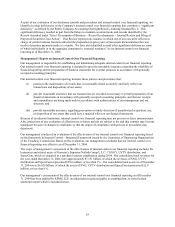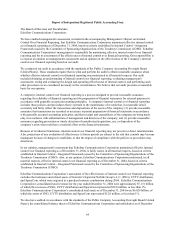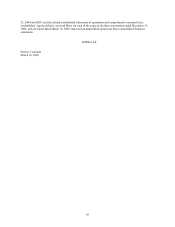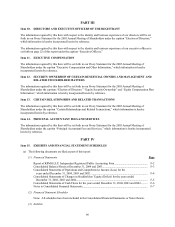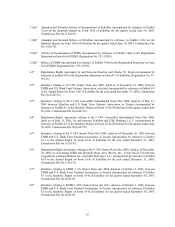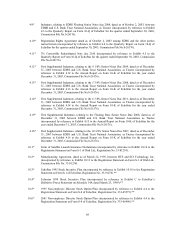Dish Network 2004 Annual Report Download - page 66
Download and view the complete annual report
Please find page 66 of the 2004 Dish Network annual report below. You can navigate through the pages in the report by either clicking on the pages listed below, or by using the keyword search tool below to find specific information within the annual report.Item 7. MANAGEMENT’S DISCUSSION AND ANALYSIS OF FINANCIAL CONDITION AND
RESULTS OF OPERATIONS - Continued
58
could require that we raise additional capital. There can be no assurance that we could raise all required capital or
that required capital would be available on acceptable terms.
Security Ratings
Our current credit ratings are Ba3 and BB- on our long-term senior notes, and B2 and B with respect to our publicly
traded convertible subordinated notes, as rated by Moody’s Investor Service and Standard and Poor’s Rating Service,
respectively. Debt ratings by the various rating agencies reflect each agency’s opinion of the ability of issuers to repay
debt obligations as they come due.
With respect to Moody’s, the Ba3 rating for our senior debt indicates that the obligations are judged to have speculative
elements and are subject to substantial credit risk. For S&P, the BB- rating indicates the issuer is less vulnerable to
nonpayment of interest and principal obligations than other speculative issues. However, the issuer faces major
ongoing uncertainties or exposure to adverse business, financial, or economic conditions, which could lead to the
obligor’s inadequate capacity to meet its financial commitment on the obligation.
With respect to Moody’s, the B2 rating for our publicly traded convertible subordinated debt indicates that the security
is considered speculative and is subject to high credit risk. For S&P, the B rating indicates the issuer is more
vulnerable to nonpayment of interest and principal obligations, but the issuer currently has the capacity to meet its
financial commitment on the obligation. In general, lower ratings result in higher borrowing costs. A security rating is
not a recommendation to buy, sell, or hold securities and may be subject to revision or withdrawal at any time by the
assigning rating organization. Each rating should be evaluated independently of any other rating.
Critical Accounting Estimates
The preparation of the consolidated financial statements in conformity with GAAP requires management to make
estimates, judgments and assumptions that affect amounts reported therein. Management bases its estimates,
judgments and assumptions on historical experience and on various other factors that are believed to be reasonable
under the circumstances. Due to the inherent uncertainty involved in making estimates, actual results reported in future
periods may be affected by changes in those estimates. The following represent what we believe are the critical
accounting policies that may involve a high degree of estimation, judgment and complexity. For a summary of our
significant accounting policies, including those discussed below, see Note 2 in the Notes to the Consolidated Financial
Statements in Item 15 of this Annual Report on Form 10-K.
• Capitalized satellite receivers. Since we retain ownership of equipment provided pursuant to our new and
existing subscriber equipment lease programs, we capitalize and depreciate equipment costs that would
otherwise be expensed at the time of sale. Such capitalized costs are depreciated over the estimated useful life
of the equipment, which is based on, among other things, management’s judgment of the risk of technological
obsolescence. Because of the inherent difficulty of making this estimate, the estimated useful life of
capitalized equipment may change based on, among other things, historical experience and changes in
technology as well as our response to competitive conditions.
• Accounting for investments in private and publicly-traded securities. We hold debt and equity interests in
companies, some of which are publicly traded and have highly volatile prices. We record an investment
impairment charge when we believe an investment has experienced a decline in value that is judged to be
other than temporary. We monitor our investments for impairment by considering current factors including
economic environment, market conditions and the operational performance and other specific factors relating
to the business underlying the investment. Future adverse changes in these factors could result in losses or an
inability to recover the carrying value of the investments that may not be reflected in an investment’s current
carrying value, thereby possibly requiring an impairment charge in the future.


